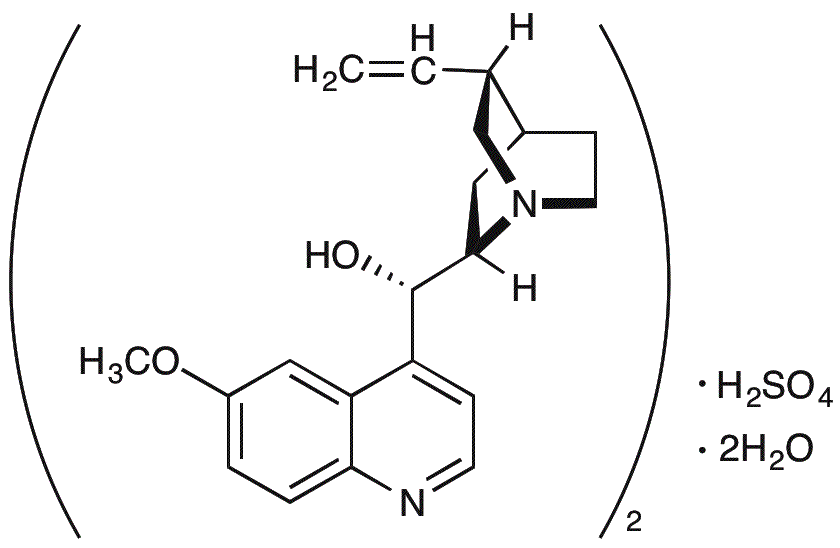Quinidine sulfate salt dihydrate is widely utilized in research focused on:
- Cardiovascular Medicine: This compound is primarily used as an antiarrhythmic agent to treat irregular heartbeats, providing a critical option for patients with atrial fibrillation or ventricular tachycardia.
- Pharmacological Studies: Researchers employ quinidine sulfate in studies to understand its effects on ion channels, particularly sodium channels, which is essential for developing new cardiac therapies.
- Malaria Treatment: In combination with other medications, it serves as an effective treatment for malaria, showcasing its importance in tropical medicine and infectious disease research.
- Drug Interaction Research: The compound is often used in studies assessing drug interactions, helping to identify potential side effects and optimize therapeutic regimens for patients.
- Veterinary Medicine: Quinidine sulfate is also applied in veterinary practices to manage arrhythmias in animals, demonstrating its versatility across different fields of medicine.
General Information
Properties
Safety and Regulations
Applications
Quinidine sulfate salt dihydrate is widely utilized in research focused on:
- Cardiovascular Medicine: This compound is primarily used as an antiarrhythmic agent to treat irregular heartbeats, providing a critical option for patients with atrial fibrillation or ventricular tachycardia.
- Pharmacological Studies: Researchers employ quinidine sulfate in studies to understand its effects on ion channels, particularly sodium channels, which is essential for developing new cardiac therapies.
- Malaria Treatment: In combination with other medications, it serves as an effective treatment for malaria, showcasing its importance in tropical medicine and infectious disease research.
- Drug Interaction Research: The compound is often used in studies assessing drug interactions, helping to identify potential side effects and optimize therapeutic regimens for patients.
- Veterinary Medicine: Quinidine sulfate is also applied in veterinary practices to manage arrhythmias in animals, demonstrating its versatility across different fields of medicine.
Documents
Safety Data Sheets (SDS)
The SDS provides comprehensive safety information on handling, storage, and disposal of the product.
Product Specification (PS)
The PS provides a comprehensive breakdown of the product’s properties, including chemical composition, physical state, purity, and storage requirements. It also details acceptable quality ranges and the product's intended applications.
Certificates of Analysis (COA)
Search for Certificates of Analysis (COA) by entering the products Lot Number. Lot and Batch Numbers can be found on a product’s label following the words ‘Lot’ or ‘Batch’.
*Catalog Number
*Lot Number
Certificates Of Origin (COO)
This COO confirms the country where the product was manufactured, and also details the materials and components used in it and whether it is derived from natural, synthetic, or other specific sources. This certificate may be required for customs, trade, and regulatory compliance.
*Catalog Number
*Lot Number
Safety Data Sheets (SDS)
The SDS provides comprehensive safety information on handling, storage, and disposal of the product.
DownloadProduct Specification (PS)
The PS provides a comprehensive breakdown of the product’s properties, including chemical composition, physical state, purity, and storage requirements. It also details acceptable quality ranges and the product's intended applications.
DownloadCertificates of Analysis (COA)
Search for Certificates of Analysis (COA) by entering the products Lot Number. Lot and Batch Numbers can be found on a product’s label following the words ‘Lot’ or ‘Batch’.
*Catalog Number
*Lot Number
Certificates Of Origin (COO)
This COO confirms the country where the product was manufactured, and also details the materials and components used in it and whether it is derived from natural, synthetic, or other specific sources. This certificate may be required for customs, trade, and regulatory compliance.


